UPDATED! One of our most popular posts in 2017, this ultimate guide to SEO techniques that grow rankings has been updated to get you ready for a successful 2018!
In today’s rapidly shifting world, SEO techniques can change on a dime—and the worst part is that you might not even know it. Hacks that could have won you a front-page result as recently as 2016 are not only obsolete now, but they may even hurt your website’s rankings.
That’s why you need to stay on top of the ball.
We spoke with Jacob Warwick, Director of Communications at Skedulo, and Jesse Teske, SEO Manager at YLighting, to get their expert thoughts on the most current SEO tactics. In this post, we’ve broken down the top SEO techniques to help you skyrocket your rankings and boost your number of monthly visitors.
Before we learn about improving your web page ranking, let’s take some time to test your current page ranking on search engine results.
Here is a free tool offered by SERPS, that you can use to determine your page ranking based on keyword search. Take some time to explore the tools and other multiple search criteria they have to offer like domain name, location and device type.
Your goal is to make the results list here and then get closer to the top of this list. Run this test to check your site ranking in the eyes of Google and Yahoo, and master the following techniques to improve upon that rank.
Effective SEO Techniques
I’ll talk about the following tactics in this post:
- Improve engagement to improve rankings
- Make your existing pages longer
- Focus on YouTube SEO
- Improve site speed
- Focus on topics instead of keywords
- Build backlinks
- Reporting and analytics
- Technical optimization
- Local SEO and Listings
- Guest posting
Let’s dig in!
Further Reading:
- Beginners Guide to SEO: Getting Started With Blogs and Articles
- HubSpot’s Global Head of Growth & SEO Explains Why Backlinks Are the Most Effective Factor for Ranking (podcast)
- The SEO Framework That Helped Propel Pinterest To Over An Estimated 72M Users (And Over 50B Pages of Content!) (podcast)
1. Improve Engagement to Improve Rankings
Simply put, engagement is the ability to hold a user’s attention. In SEO terms, it is a measure of the amount of time spent on a page.
Although Google hasn’t officially declared it, there is evidence to suggest that this search engine giant does reward sites with strong user engagement with higher page ranking.

According to research done by Wordstream, there’s a definite correlation between the bounce rate of a page and its organic position. The higher a web page’s bounce rate is, the lower it’s ranked in search.

Google’s reasoning is that if a user spends more time on a page, it’s probably because she found the page useful. And since Google only wants to deliver the best possible results to its users, it will push sites with strong engagement up in the search engine results pages (SERPs).
So how can you improve your site’s engagement?
Here are five tactics you can use to give your existing content a boost in search engines:
A) Format Your Posts for Easier Reading
Good formatting can instantly improve your page’s readability. This, in turn, can improve your engagement rate. According to eye-tracking studies, the following three formatting tactics can help increase your content readability:
- Shorter paragraphs: Limit each paragraph to 2-3 sentences at most. It’s even okay to use one-sentence paragraphs if necessary, but use them sparingly or your post will look like a bullet-pointed blog without the bullets.
- Shorter sentences: Longer sentences are hard to follow onscreen. When possible, break longer sentences into multiple shorter sentences.
- Sub-headers: People don’t read on the web; they scan. To make scanning easier, use plenty of clear and informative sub-headers to guide readers down a page. In addition to this, call out points that are important by emphasizing them in bold. Readers should be able to scan your blog post and get the “gist” of what you’re talking about.
- Bullet points: When you have a lot of data — stats, facts, ideas, examples — packed into one paragraph (like this one!), it makes it easier to scan when you list them with bullet points.
Here’s an example of poor formatting:
Knowledge of the existence of the Law of Attraction is a huge benefit in itself. Most people live their entire life and never realize that there thoughts are creating their reality. When one discovers this universal truth the entire world begins to open up. After much hard work and practice you will begin to see life-changing and long -lasting results from utilizing the techniques and strategies taught here. There are many ways to use the law including through daily affirmations, visualizations, goal setting, changing think patterns and of course tapping into the universal storehouse of information.
Here’s an example of the same paragraph, but with good formatting (here are some ways you can improve block of text):
Most people live their entire lives and never realize that their thoughts are creating their reality.
After much hard work and practice you will begin to see life-changing and long -lasting results from utilizing the techniques and strategies taught here.
Here are some ways you can use the law of Attraction to your benefit:
- Daily affirmations
- Visualizations
- Goal settings
- Changing link patterns
B) Use Bucket Brigades
A “bucket brigade” is a copywriting technique designed to keep capture a reader’s interest and keep them on your page.
It essentially involves breaking an idea into multiple sentences, using a trigger word or phrase (as simple as “Look.” Or as lengthy as “The secret to great copywriting is this”) and then ending the sentence with a colon.
Look at this example from Backlinko:

C) Use Images Throughout Your Content
Including professional, high-quality images (photos, graphs) throughout your content is an easy yet powerful way to increase engagement. For one, images help you show an idea, not just tell it (a picture tells a thousand words, right?).
Secondly, images help you break content into different sections. And finally, people just like pretty pictures.
For example, take a look at how Growth Everywhere uses images to clearly illustrate the step-by-step content in How To Do A Content Cleanup (And Grow Your Organic Traffic):
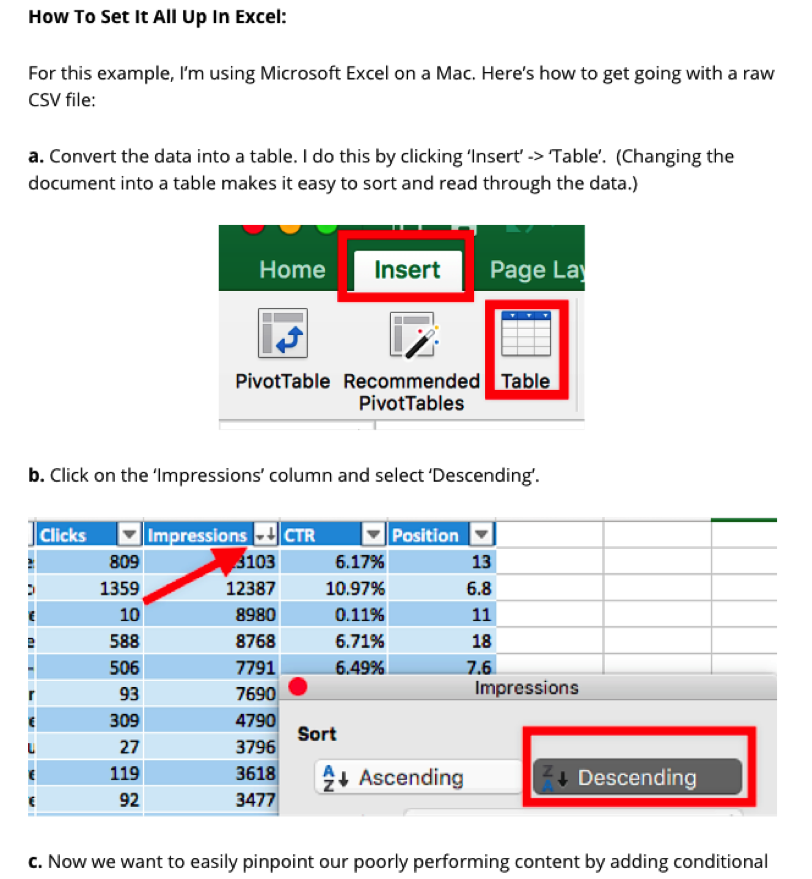
On Single Grain, charts and screenshots are frequently used to divide up content into separate sections, like this example from The Ultimate Guide to Mobile Advertising:

D) Write in the Inverted Pyramid Style
If you went to journalism school, you know all about the inverted pyramid style of writing:

This method means giving away the most valuable information at the top of the article, and following it up with less important information. If readers tend to scan and rarely make it to the bottom of an article, it makes sense to give them what they want as soon as they land on the page.
E) Improve Your Bounce Rate
Writing well, delivering value, and proper formatting only go so far. Another key part of engagement is lowering your bounce rate, which is the percentage of visitors who land on your website and leave without interacting further.
Bounce rates can be raised by a number of factors, from incorrect implementation to poorly designed landing pages.
More often than not, however, high bounce rates result from poor usability and an awkward user experience (UX). While these problems vary from site to site, they are very easily remedied with several popular online tools, such as:
- Crazy Egg – Clever and intuitive, Crazy Egg helps subscribers rate and understand user experience with their rich visual aids like heatmaps, scrollmaps, confetti, and overlays.Each of these are graphic representations of one aspect of UX.
For instance, heat maps are colorful representations of where users have clicked on your site, while scrollmaps show you just how far down the page your users scroll before leaving.
With this data, it’s possible to figure out what your best design features (or flaws) are, and correct them accordingly. On Crazy Egg’s home page, they’ve included an example of a heatmap of their site which shows where their visitors clicked:

- Optimizely – Founded by Dan Stocker, the man behind the digital component of Barack Obama’s highly successful digital campaign of 2008, Optimizely specializes in A/B testing—a scientific, data-driven way to test websites for maximum usability and engagement.
In A/B testing, multiple versions of a web page are randomly shown to users, compared against a control page (generally the existing website), and then analyzed for effect.
The biggest advantage of a proper A/B testing process is that marketers can understand how even the tiniest changes can positively affect their website, such as moving the buy button to the left or changing its color from red to blue.
Here’s our guide on running A/B tests that actually increase conversions.

Many A/B tests can have surprising results.
For example, Michael Aagaard from ContentVerve found that moving his CTA to the bottom of the page actually increased conversions by 304% compared to placing the CTA above the fold. This goes against most “best practices.”
In this case, users needed to understand the benefits of signing up before they were ready to submit their email address. Placing the CTA at the bottom let users get a sense for the value of the service first.
The genius of Optimizely is that it massively simplifies something that would otherwise require a team of dedicated, experienced UX designers and researchers to carry out.

- Google Optimize – Along the same lines, Optimize by Google Analytics also assists marketers in improving and maximizing customer engagement and conversion. As a free version of its Optimize 360 program, Google’s Optimize is a streamlined, user-friendly software that simplifies A/B testing and includes advanced modeling to improve engagement and targeted experiences.
But perhaps the biggest draw of Optimize is that it seamlessly integrates with Google Analytics, allowing marketers to further leverage their existing resources.
With Optimize, marketers can use existing Analytics metrics as a starting point, which allows them to rely on a familiar interface as they move on to deeper and more complicated experiments.
Here’s a shot of the Google Optimize user screen. Notice that it gives recommendations and suggestions for the optimal interface:
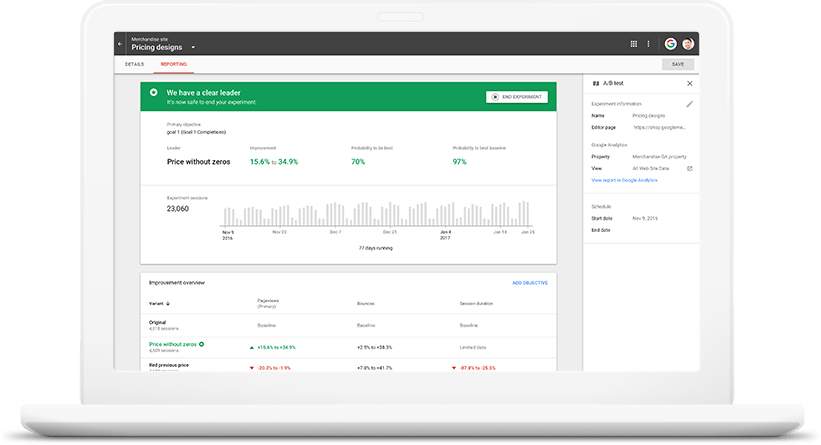
- User Testing – While Google Optimize and Optimizely are essentially DIY UX tools for marketers and small business owners, User Testing is far more specialized. In its most basic form, User Testing is more of a pure research tool, gathering commentary from target audiences and offering marketers detailed videos of user interaction and behavior.
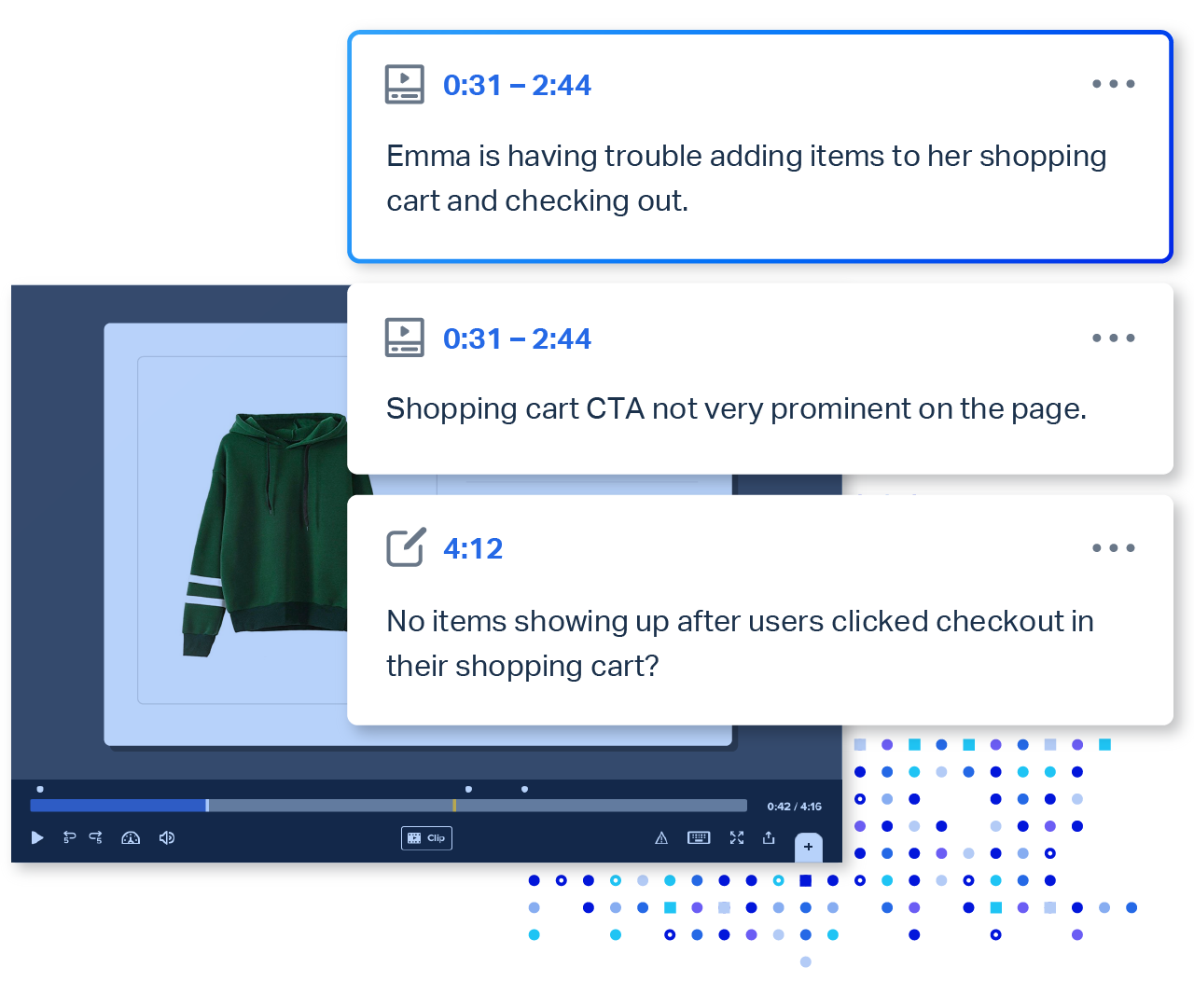
User Testing customers have the option of capturing and understanding meaningful interactions with their product. New features make it easier to extract and highlight customer intelligence.
- Don’t Make Me Think – These four tools are some of the best UX testing programs available today. Yet one of the best UX resources isn’t digital, but rather a book: Don’t Make Me Think, a groundbreaking work by UX designer Steve Krug that has sold 100,000 copies over 5 years.Witty, entertaining and down-to-earth, Don’t Make Me Think offers actionable advice and useful mindsets for novices and veterans alike.
With its conversational tone and engaging manner, Krug’s work gets readers into the habit of critically examining and rethinking everything about their websites, including even the tiniest details, like misplaced buttons or unwieldy site maps.
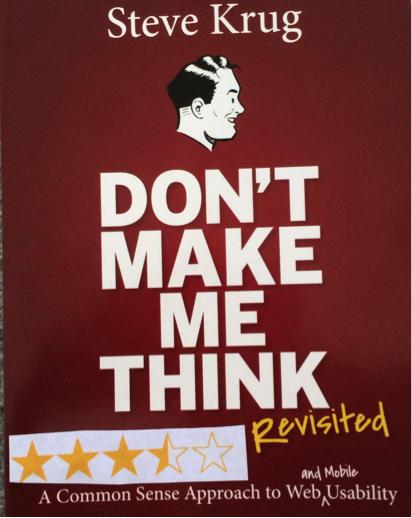
- Google Search Console – Click-through rates, or how often viewers click on your ads after seeing them, are some of the most important metrics of success and failure. A high CTR reflects positively on your content and advertising, and in turn widens your funnel for more prospects to enter, engage with your brand and content, and ultimately close, be it in the form of purchases or subscriptions.
There’s also strong evidence that click-through rates will influence your website’s Google search ranking, though this is difficult to confirm given the company’s secrecy surrounding their algorithms. Either way, improving CTR is absolutely a good investment for the long-term health of your business.

Luckily, there are programs like Google Search Console and Tableau, which allow marketers to identify critical keywords which are performing (or underperforming) for their position, understand why and, most importantly, quickly visualize the terms and pages to target. With these programs, marketers can turn around underperforming terms by rewriting titles and descriptions, thereby increasing CTR and drumming up traffic.
- ClickFlow – ClickFlow is a tool we built to help companies increase organic traffic without more backlinks or posting more content. Through ClickFlow, companies can automatically see which pages on their site have the most potential to grow revenues – such as pages that have high impression count in search but a low click through rate. Using that information, ClickFlow will keep track of headline tests to help grow your click throughs from search terms you already rank for.
The tool drives up your bottom line by showing you how much revenue you’ve gained and how much you stand to gain. It’s been used by companies like LeadPages, Drip, The Atlantic, and more.
Further Reading:
- 10 Google Search Console Hacks to Boost SEO
- The Top SEO Tool To Skyrocket Your Organic Traffic
- Eric Siu’s Favorite SEO Tool
- How to Increase Your Organic Traffic with Google Search Console (Quick Win)
2. Make Your Existing Pages Longer
A recent study by Backlinko concluded that the longer the content, the higher the likelihood of it ranking at the top of the SERPs.

However, writing 2,000+ words for every blog post is not for everyone; it’s an intensive, time-consuming process. Instead, it’s much easier to take a page from 1,200 words to 2,000 words than to go from 0 words to 2,000 words.
Existing content already has authority and an established readership. So rather than writing something entirely from scratch, it’s much simpler to find a post of yours that is already doing well on Google, refresh it with updated information and extra content, and rely on existing signals to make it rank for terms.
Here’s how you do it. First, under “Search Traffic” in Google Search Console, click on “Search Analytics.”
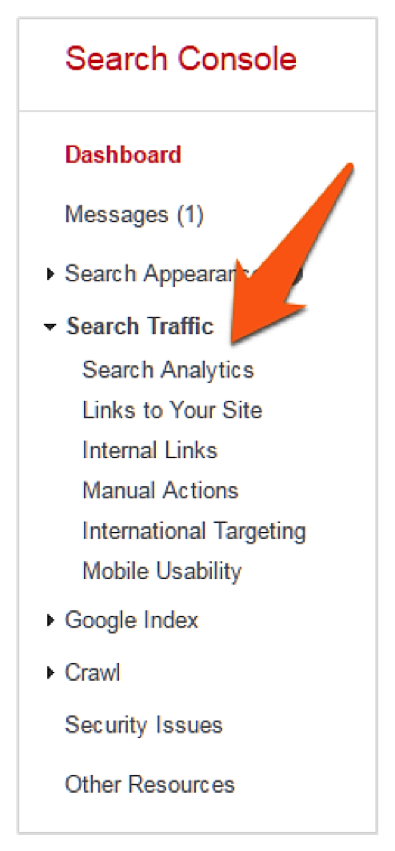
On this page, check “Position” and select “Pages”:

Try to find pages that are ranking between positions 11-30 on Google. These are ideal candidates for additional content that can increase their rankings.
3. Focus on YouTube SEO
YouTube videos rank in top 10 of Google search far more frequently than any other types of videos. According to Forbes, YouTube is also the second most popular search engine with more than 3 billion searches per month, surpassing Bing, Yahoo, and AOL combined.
Focusing on YouTube SEO will push your website onto the first page on Google and get you traffic from YouTube as well. The result? Twice the traffic with the same content.
Here are 3 ways to improve your YouTube SEO (after creating your videos, of course):
Learn More: The Complete Guide to YouTube SEO
A) Make Your Video SEO Friendly
The filename, the title, the description—all these elements affect your rankings.
- Video Title – Crafting a compelling video title is a balancing act—you have to make the title SEO friendly and make it clickable. Ideally, you should follow the same convention in your video titles as you would in your blog posts: to get clicks and shares, include keywords as well as power words.
Here’s a great example:

Another tactic is to use your keywords at the start of the title, then add a sub-header after a colon to drive clicks. Here’s an example:

At the very least, your title should have 5+ words and include a broad target keyword. This will not only help you rank in SERPs but also get you more clicks on YouTube.
Learn More: 20 Ways to Grow Your SEO Rankings
- Video Description – Because Google’s spiders can’t “read” videos, they will rely on your written description to determine what your video is actually about. So instead of just throwing in some target keywords, try creating short blog posts that describe your video content in detail.
It can be as short as this example from Growth Everywhere:
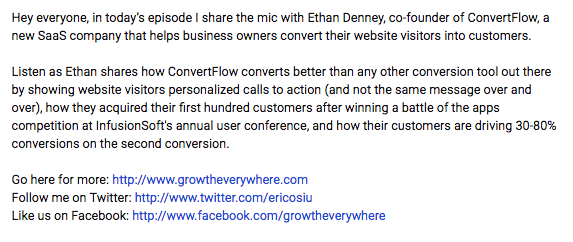
Or as long as this example from James Stafford:
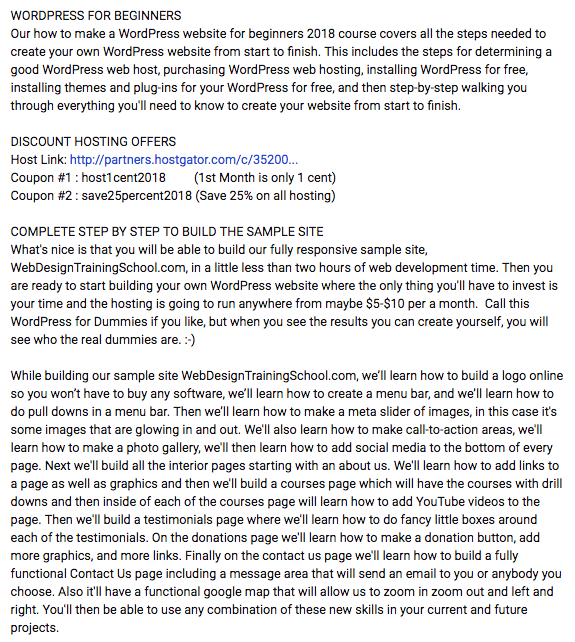
This tells Google—as well as your readers—exactly what your video is about. Since most of your competitors aren’t doing it, it will also help you rank way faster.
B) Make Longer Videos
Like content, longer videos tend to do better in YouTube search.
Try it yourself: type in a popular keyword or topic and see what shows up at the top of the page. For example, here’s what you’ll see when you type in “wordpress”:
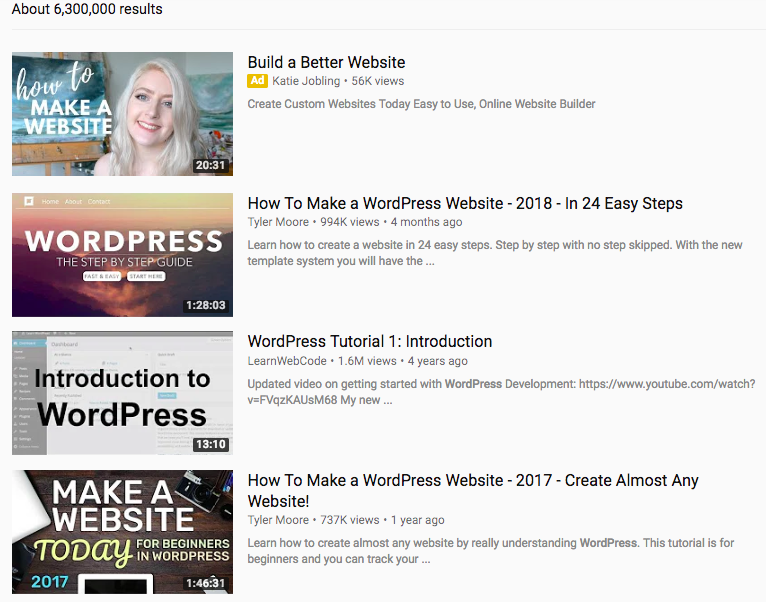
Or when you search for “photography tips”:
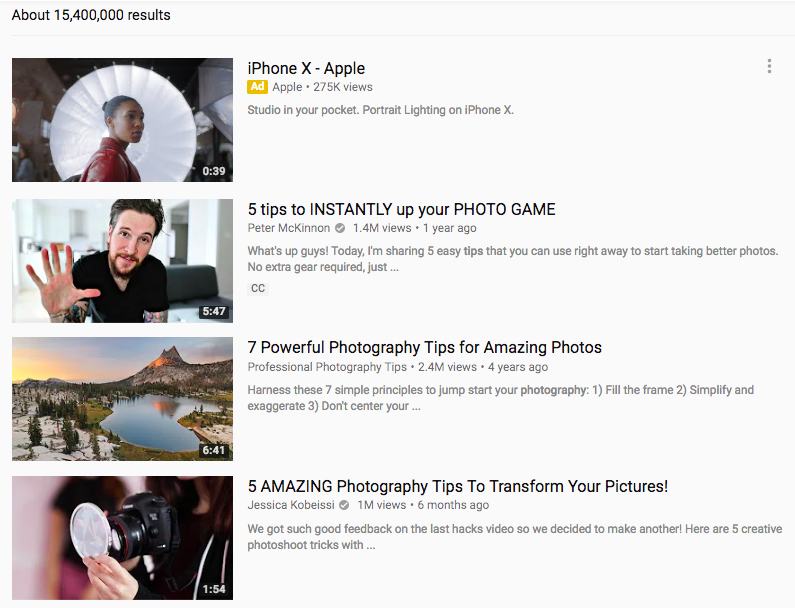
Try to make your videos at least 5 minutes long. As with written content, longer videos tend to get the most traction.
Learn More: A Youtube Video Marketing Guide to Increase Prospects in Your Funnel
C) Use Better Video Thumbnails
A better video thumbnail won’t necessarily help with your SEO, but like a great headline, it will help you get more clicks. This means that you can often earn more views than higher ranked results, all thanks to your choice of thumbnail.
A strong thumbnail should tell viewers exactly what the video is about. Try to use a compelling image along with a title card. Here’s an example:

4. Improve Site Speed
Back in 2010, Google announced that it would be using site speed as a ranking factor and since then, Google has consistently emphasized the importance of site speed.
First, it launched the PageSpeed tool to help developers improve site performance, followed by the Accelerated Mobile Pages Project to boost speed on mobile sites.
Recently, it launched another tool called Think with Google to help gauge how responsive (or mobile-friendly) a site is, which includes speed as a parameter.
Clearly, Google wants your website to load faster than it is right now. But how fast?
Unfortunately, the exact definition of “site speed” is open to speculation. According to the surveys done by Akamai and Gomez, nearly half of web users expect a site to load in 2 seconds or less. If the site fails to launch in 3 seconds, there is a good chance they’ll abandon it.
You should work on your site’s speed not only to work your way up Google’s rankings, but also to increase conversions. For instance, one survey found that nearly 79% of web shoppers who have trouble with website performance won’t return to the site to buy again.
While improving site speed is a pretty big topic, check out this HubSpot article to improve page load times.
Learn More: Using Google AMP to Boost Site Speed and Mobile Optimization
A) Use Kraken.io to Optimize Images
Images are usually the largest components on any site (in terms of file size). By compressing them, you can often cut down page size by 30-40%.
A quick way to do this is to use Kraken.io. This tool automatically compresses all images uploaded to your WordPress blog. It also has an API to make image compression for non-WordPress sites easier.

B) Use Browser Caching
Caching is the mechanism for temporarily storing web data such as HTML pages and images in order to reduce bandwidth usage.
If you’re on WordPress, enabling browser caching is as simple as installing a caching plugin like W3 Total Cache or WP Super Cache.
For non-WordPress sites, browser caching is a little trickier. One quick way to do it is to change your .htaccess file. Follow the instructions here to learn how to do this.
C) Content Delivery Network
A CDN is a network of servers based throughout the globe. When visitors access your website, they are delivered the site from a server that is as close to their physical location as possible, thereby improving site speed.
Using a CDN is a easy fix to instantly improve site speed and will have an immediate impact on site performance.
A quicker way to improve your page performance is by using browser add-ins like YSlow to determine the exact bottlenecks and propose respective fixes.
This tool will help you monitor your website and list all the factors that are dragging down the site’s speed. They also suggest best practices to follow to achieve the same. The best part is the suggested fixes are described in non-technical language which can be comprehended by anyone.
Here are some more technical changes you can make to further improve your site load speed:
- Load JavaScripts at the Bottom: Take those script tags you see in any javascript webpage, and move them to the end of the page. You’ll see a significant improvement in page load performance. This is one of Google’s crucial performance metrics when displaying search results.
- Lazy load images – This change will reduce the page load time drastically. Lazy loading basically avoiding to load all images on initial page load. In other words, load them after the user scrolls to that section of the page. Here’s a tutorial that lists a bunch of ways you can modify your images to save your bandwidth.
5. Focus on Topics Instead of Keywords

Google is evolving and so is its algorithm. Its objective now is to understand the intention of the users: what users expect, what they are looking for, and more specifically, what search results would best help answer their query.
Plus, for an increasingly large number of queries (22.6% of queries in 2014, 31.2% in 2015, and 40% in 2016), Google shows “rich results” that include the best answer at the top of the results:

Don’t expect your website to end up on the first page of Google simply by creating keyword-focused content. It’s not enough to look at keywords alone. We need to look at the context around them.
In short, you must consider what your users are looking for rather than coming up with different ways that users can phrase a search query. Here are two things in particular you should consider:
A) Know Your Target Audience
What kind of content you’ll create will depend on your audience. The better you know them—their location, age, and likes—the better the content you’ll create (and the better your SEO).
For example, suppose your keyword tool shows that “android” has a lot of search volume. People searching for it could fall into several categories:
- Mobile users searching for Android help
- Star Wars fans looking for droids
- Robotics enthusiasts looking for information about androids
Without knowing your target audience, you might end up creating content for all these topics, which would win you neither readers nor good rankings. By building a detailed buyer persona, you’ll be better able to zero in on topics that matter to your readers.
B) Organize Content into “Themes”
Instead of focusing on standalone keywords, organize all your content into different “themes.”
For example, if you run a website about WordPress, you might have three types of readers:
- Casual bloggers who are taking the first steps with using WordPress
- Experienced users who want to learn WordPress tips and tricks
- Entrepreneurs who want to use WordPress to build their businesses
To target each of these types of readers, you can organize your content into different themes that cover multiple topics, such as:
- How to Use WordPress for Business (topics: WordPress marketing plugins, marketing advice, etc.)
- How to Optimize WordPress (topics: WordPress customization, WordPress development, etc.).
- How to Build Your First WordPress Blog (topics: Installing WordPress, essential WordPress plugins, etc.).
This is far more reader-friendly than simply creating content for specific keywords.
C) Research Keywords—and Use Them Sparingly
At the same time—keywords still matter. Organizing content thematically is very important, but it’s a mistake to ignore keywords entirely, given that they serve as signposts to Google’s spiders, signaling topics and giving hints as to the nature of the content on the website.
Still, the keyword aspect of SEO is becoming increasingly difficult with Google Adwords hiding volume data.
Luckily, there are a number of tricks and tools that can help marketers find topics and volume data. Google itself is a good way to get related search ideas. Just type “sushi restaurants in San Francisco” into the search bar of Google Chrome and you’ll be presented with related images along the middle of the page, such as the names of specific restaurants, times they’re open, and where they’re located.
This is a strong hint for developers to include these topics in their content, or to create pages to leverage these related images.

Read on for some extremely useful tools that can help you find and optimize keywords:
- Keyword Explorer by Moz – A one-stop shop from the SEO specialists at Moz, Keyword Explorer is a versatile, dynamic program that covers nearly every aspect of the keyword process. With Keyword Explorer, marketers can brainstorm keywords, build lists and filter them by topic; you can analyze metrics, click-through rates and other measures of effectiveness; and you can even spy on and assess keywords used by your business rivals.
- SEMRush – Another great tool for SEO analysis, particularly where it concerns business intelligence, SEMRush allows you to identify and analyze the keywords that your competitors are using. Enter your competitor’s URL into the SEMRush search bar and you’ll be provided with a list of SEO keywords, along with their rankings and traffic. For instance, a search on Title Boxing, one of the most popular online boxing and kickboxing retailers, yields 90,500 organic searches for the term “punching bag” (fourth overall), as well as 60,500 results for “title boxing,” the name of both their in-house brand and retail store.
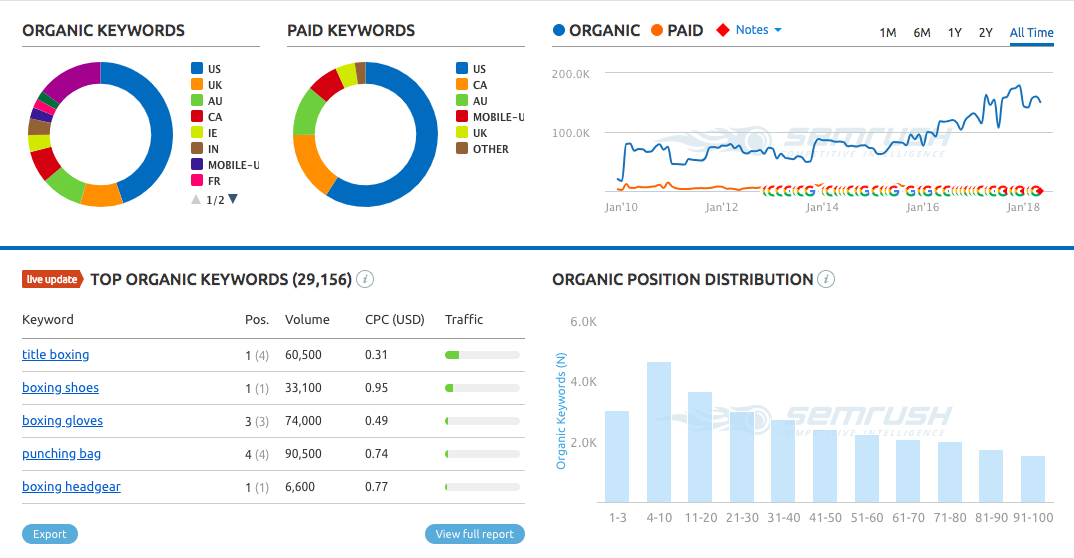
Interestingly, SEMRush also allows users to use a competitive positioning map, where they can see overall website traffic and keywords: Title Boxing boasts 150K+ in search traffic and 29K in keywords, far outpacing their closest competitors.
- Ahrefs – An extremely versatile company, Ahrefs offers a wide range of products, including backlink checkers, content explorers and position trackers. For our purposes, however, we will focus on their expansive, adaptable Keywords Explorer, which allows marketers to search nearly 3 trillion keywords in over 170 countries, assessing metrics like keyword difficulty, click-through rates, related keyword lists and search volume.
When considering which keyword tools to use, look for something that allows you to monitor a high volume of keywords broken down by relevant themes. Additionally, the best tools must ensure that you can track all your competitors, from large corporations to small, up-and-coming firms.
As always, go for quality and not quantity. It’s better to get 10 conversions from 100 visitors than it is to get 10 conversions from 1,000 visitors. Rather than casting a too-wide net, focus on keywords and topics that are within your niche, ones that you can optimize for and be the authority on. Fill in these gaps and establish yourself as an expert in this smaller field before tackling larger and broader keywords where the competition is much fiercer.
6. Build Backlinks
Despite what you might have heard, building backlinks is still crucial for good rankings.
According to Google, links are still the #1 factor when it comes to determining search rank. Gary Illyes, Chief of Happiness at Google, says that “ranking without links is really, really hard.”

What has changed is the way you must build backlinks if you want good results. Low-quality links that are easily spammed—blog comments, paid links, etc.—don’t seem to work anymore and can actively harm your site.
Links that are earned—through high-quality content, outreach and influencer marketing—on the other hand, are safe and extremely effective.
Further Reading:
- 5 Ways Cold Emailing Can Help Generate Backlinks
- How to Build Premium Quality Backlinks to Boost Ranking
- Effective Backlink Building with Blogger Outreach
7. Reporting and Analytics
A critical part of SEO is reporting and analytics, which are indispensable to improving marketing strategies. By setting up an analytics platform to track both micro and macro events, you can understand your customer’s journey from your sales and marketing funnel.
For instance, what content really appealed to your customer? What part of the website had the most UX issues? Which page was the least (or most) visited, and why?
A) Datastudio
Having the ability to tie online data back to offline data to get a full 360 view of how your content and marketing is performing.
One great tool to help you do this is Google Datastudio, which helps you aggregate data from multiple sources (rankings, traffic, conversion data) into a single interface. You can even share your data internally or with clients. Most importantly, these metrics can help you determine the effectiveness of your SEO strategy and whether you need to pivot or change tactics.
Along those lines, always be on the lookout to see what your competitors are doing, and how well it’s working. What techniques are they using? How have they changed their approach? What mistakes have they learned from?
B) Wayback Machine
One great tool to see how your competition has changed is Wayback Machine, which allows marketers to access petabytes of archived web pages. By sifting through Wayback Machine’s extensive database, you can track the evolution of your competitor’s brand and web presence, taking note of factors such as changes in UX design or differences in copy from one web version to the next.
Still, you shouldn’t implement something just because your competitor is doing it, whether that’s designing a website a certain way or using specific copy or images. This is especially true for larger websites like Amazon, which have much more leeway with search engines. Thanks to their numerous, highly skilled staff, they can test small changes and measure results with a high degree of accuracy.
If used correctly, Wayback Machine has some interesting lessons to offer any company. Take a look at these two screengrabs of Title Boxing. The top picture is a screengrab of Title’s homepage from Wayback Machine, circa 2007, while the bottom one is a screengrab from 2018.

The differences are pretty clear. In 2007, the web layout was much more cluttered and crowded, with small, hard-to-navigate sidebars squeezing some small, insignificant-looking pictures in the middle advertising daily specials.
In 2018, however, the user experience is much more streamlined. Visitors are greeted with a clear, easy-to-use sidebar at the top, labeled with categories like “Gloves,” “Punching Bags,” and many more. A large, sliding image in the center replaces the tiny, hard-to-notice ads from 2007, allowing buyers to see exactly what is on sale. The new website is almost minimalist, doing away with the previous confused, slightly chaotic format.
Clearly, Title has come a long way when it comes to UX, testing their changes and eventually settling on this new, simpler design. Still, it’s very likely that plenty of testing, design and redesign was put into this process, which is clear when you track their changes through Wayback Machine.
Be strategic about your changes, test them thoroughly, and examine how your competitors’ websites have evolved with Wayback Machine.
8. Technical Optimization
SEO and content tips aside, it’s absolutely essential to have a solid website, without worrying about any technical issues that may arise. With that being said, here are some tips and techniques to help you ensure that your website is up to par.
A) Switch to HTTPS
First off, do yourself a favor and switch to HTTPS, the most commonly used, securest version of the old http web protocol. HTTPS is the secure version of HTTP.

It’s a best practice that will help your website boost its SEO presence, stay secure, and make it harder for malicious parties to break in and take advantage of your website.
Granted, transitioning to HTTPS is easier said than done, and requires a multi-step process. When the Atlantic, a highly-regarded, well-established media organization, decided to move to HTTPS in early 2016, the transition was complex. First, content had to be scanned individually, then ported over and checked for compatibility. The process was repeated with ads, and once compatibility and security were ensured, the website slowly went live in order to guard against traffic loss and unforeseen errors.
If you’re a smaller organization, your process will likely be less painstaking or time consuming. All the same, moving to HTTPS is a necessity in a world of cybersecurity threats and heightened SEO and SEM requirements.
B) AMP for Mobile
AMP, or Accelerated Mobile Pages, began as a Google-backed open initiative to allow publishers to easily create responsive, mobile-optimized content.

Envisioned as a way to quickly render content on mobile devices like smartphones and tablets, AMP combines three components:
- HTML tags, which help common web patterns render quickly
- AMP JS, a library that manages the resource loading and best practices necessary for fast rendering
- AMP cache, a content delivery network that both loads content and ensures speed.
Since AMP was only incorporated into the search giant’s results in February 2016, the format itself is still fairly new. For those of you who use WordPress, AMP should be much easier to implement than a home-grown CMS from scratch.
Learn More: Using Google AMP Pages to Boost Site Speed and Mobile Optimization
C) Budget Money for Crawlers
To ensure that Google is crawling your preferred pages and not pages that don’t appear in its index, turn to crawl programs like Deep Crawl or Botify. These SEO crawler programs are similar to Google’s own crawlers and will give you an overview of how your page will perform in SEO rankings.
- Deep Crawl: Possibly the most comprehensive tool of its kind available today, Deep Crawl is the equivalent of a physical exam for your website, checking its SEO health and viability in an increasingly crowded market.In short, Deep Crawl will provide you with a laundry list of necessary improvements and errors, such as duplicate content, broken pages, flawed titles, descriptions and metadata.
- Botify: A cloud-based crawler that has already signed up big names like Expedia, eBay, and BlaBla Car, Botify is one of the strongest crawlers available today, short of Google’s own secret algorithms.Not only can Botify check whether Google has crawled your page, it can also offer suggestions on how to restructure web content and site maps to optimize your web page for Google’s crawlers.Still, even with its diverse functions and fast crawl speed, Botify’s disadvantage is that it can be expensive: basic plans begin at around $500 per month, while larger options for bigger firms can run up to $10,000 annually.
D) Correct Your Semantic Markups
To help Google understand your data or to show your website smartcards and voice searches, you need to ensure that your semantic markups are correct.
Semantic markups are essentially HTML tags which can help emphasize key information on your website.
For instance, a heading tag (H1) can help a crawler understand precisely what your content is about. If you tag “Five Holiday Destinations in Eastern Europe” with a H1, then a crawler will know to sort your blog post under relevant categories, such as holidays or Eastern European travel.
In short, edit your semantic markups so that they reflect your data and information as accurately as possible.
E) Fix 404 Errors
Nothing will sink your website faster in search rankings than a 404 error, when a search engine can’t find the desired web page and leads to a dead end. It’s in your interest to fix these broken or missing pages and re-engage your users as soon as you can.
Whatever platform you use, be it Google Analytics or Oracle, take a look at the number of pageviews for your 404 page. Then add URL as a secondary dimension and fix the biggest offenders first.
This way, you can boost UX and regain any inbound links from those pages.

Learn More: Data-Backed Best Practices for Building a Killer 404 Page
F) Web Browser and WordPress Plugins
To make your job easier, there are a number of web browser and WordPress plugins that you can use. We’ve listed a few of them below, along with a brief description of their capabilities and common uses.
- Redirection by WordPress: An easy plugin that seamlessly integrates into your WordPress interface, Redirection allows you to keep track of 404 errors, 301 redirects, and generally keep your website tight and functioning smoothly. It’s especially useful for those who are moving their web pages from one site to another, or for directory changes.
- Canonical: This plug-in handles content syndication, which essentially allows other blogs to publish your work (similar to franchising) without hurting your website’s SEO ranking—simply by adding a rel=canonical tag.You can get your brand and content out on the web in multiple outlets, ensuring a greater reach and bigger audience without hurting your own search results.
- Ultimate Nofollow: This simple, easy-to-use plugin automatically inserts `rel=nofollow` and `target=_blank`into your hyperlinks, which alerts search crawlers.This way, you won’t accidentally boost the rankings of other pages simply by linking to them, or fall victim to pageview or link-related spam.

- SEOQuake: A plugin for your web browser, not WordPress, SEOQuake allows users to quickly and seamlessly assess SEO attributes of any website without opening up extra programs. You can audit your page’s SEO health, compare SEO metrics for a number of pages, and analyze both external and internal links on any given web page.
9. Local SEO and Listings
In the digital era, it’s easy to forget that people still visit physical shops and establishments. True, they may use online resources to research, but plenty of commerce is still conducted in real life. If you have a brick-and-mortar business, you can’t neglect local SEO and listings if you want to stay profitable.
A) Correcting Your Listings
As powerful as search engines like Google or Bing are, they still can’t be everywhere at once, and have to rely on additional information from local, on-the-ground sources, which gather, aggregate, and submit relevant data for area businesses. These aggregators will do much of the legwork, pulling information from physical directories (like Yellow Pages) or scanning business registrations.
In a nutshell, bigger search engines will rely on these data aggregators to fill in the gaps of the existing information already in their databases, and will also cross-check to make sure that the facts are up-to-date. Problems arise, however, when aggregators collect out-of-date data, leading a search engine like Google or Bing to list the wrong information, like an old address for your business or a disconnected phone number.
Learn More: How to Do a Comprehensive Local SEO Audit
That’s why it’s critical to ensure that your physical contact information is as current as possible.
The first step is to identify any obsolete information that may be out there. Because Google is the largest search engine, start with Google My Business, its free-to-use listing service, and update your data accordingly. Be sure to list important details like extra locations, the latest opening hours, and what forms of payment are acceptable.
Then, use a local directory management service, which carries out the painstaking, tedious work of scanning countless local directories, interacting with data aggregators, and correcting any old information. The best of these are Moz Local and Yext, which can help you avoid any glaring inconsistencies that can hurt your revenue stream, or even worse, trick Google’s algorithms into thinking that you’re a different business entirely.
Next, use your directory management service to hit at least some of the major data aggregator services. While these companies do vary by location, some of the bigger names are Infogroup, Acxiom, and Localeze, all of which provide information on millions of business listings to larger search engines.
From that point on, local search listings should be accurately and automatically updated by your management service.
Learn More: 10 Free Local SEO Tools for Small Businesses
B) Technical SEO for Local
Carrying out technical SEO for local search engines is a similar process.
You may be questioning the point of optimizing for local search engines, especially given Google’s unquestioned dominance of the search landscape. Even so, local search engines are still extremely useful. After all, if you’re a physical, brick-and-mortar establishment, you will benefit greatly from having in-store visits.
Learn More: How to Get More Reviews for Your Local Business
Here are some useful terms and techniques to ensure that you optimize your business for local searches:
First, understand that schema markup is one of the most powerful, least used parts of SEO today. Schema are basically brief snippets of data that can give extra information to search users and search engines. Best of all, schema markups don’t require extra coding, and can be inserted through Schema.org, a rare collaboration between Google, Yahoo, and Bing.
In the case of the example below, the schema gives extra information about the venue’s hours, location, general information, and more:
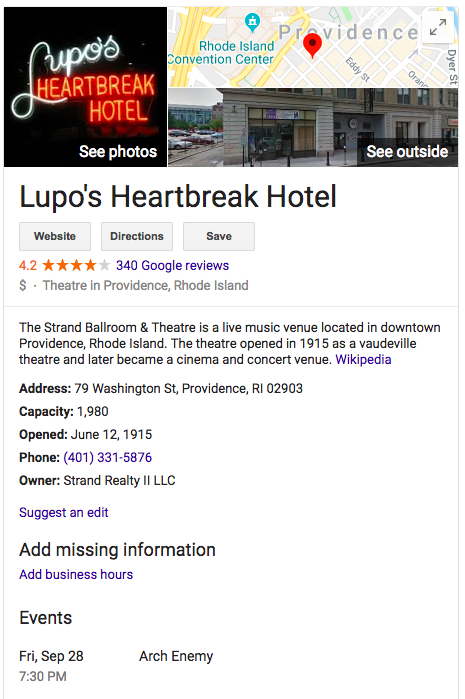
As you can see, schema is a game-changer: you can make your site more visible in Google and quickly add brief, useful data for the benefit of users.
If you want to go a step further, you can also include a JSON (Javascript Object Notation) injection through Google Tag Manager. JSON is a form of data that is easily read by humans and artificial intelligences alike, and familiar to anyone who has ever used C++, Javascript, Python, and more.
With Google Tag Manager, however, it’s easy to combine schema and JSON together to further boost the strength of your schema, resulting in a higher CTR and visibility, without having to spend precious time and lines of code. Granted, the learning curve is a bit steep for those who aren’t familiar with Javascript or another basic programming language, but once set in place, JSON injections can help execute and put structured data in place simply and efficiently.
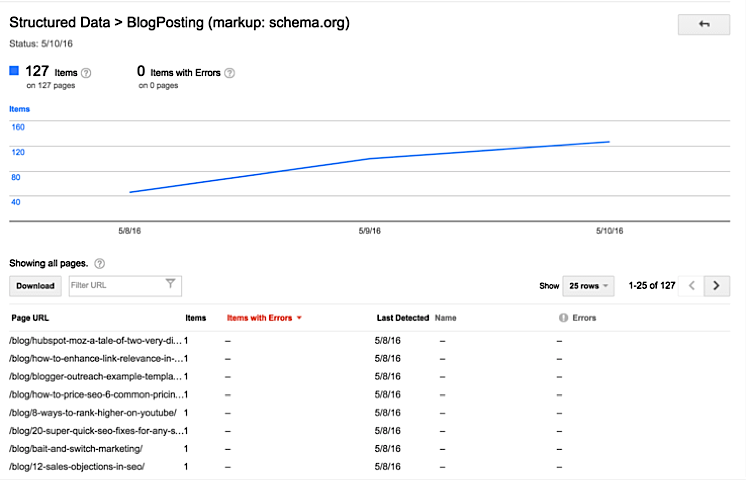
10. Guest Posting
Guest blogging is a method used by bloggers to increase blog traffic where they write posts to be published on another blog.
Few years ago this method was deemed dead because of all the spammy content and paid links. However, this is not true anymore. As long as the blog post has original and high quality content, Google will not penalize you. Just be sure to avoid duplicate and repetitive content.
The key to building a blog to rank higher is to have a niche in your domain and build your blog posts around this topic. Pick a specific domain instead over a broad topic one. Become an expert in that domain.
If you’re an amateur blogger on the block, your first goal would be to increase SERP ranking. If you’re new to this space, it’ll definitely take a while to increase ranking. Guest blogging is one way to climb up the ladder sooner than you might otherwise be able to do. You have two ways to do this. You can offer to write a guest post for a popular blog in your space or request a popular blogger to write a guest post for your blog. Both ways it’s a win win for you.
Now how do you approach an authoritative blogger to publish your content on their blog? Here’s a how:
First, find top bloggers in your niche. Search for ‘Top blogs/bloggers in software development’, replace ‘software development’ with your niche. If you did your homework, I’m sure you’ll recognize some of these blogs in the search results.
Find the blogger’s contact, LinkedIn or social media account and reach out to them and offer to write a guest post. Since you’re asking for a favor, be proactive and propose a list of titles to write that they’d be interested in. This makes their job easier by picking a title.
You can also use tools to find top blogs by their geographical location.
If you’re particular about your target audience location use relevant keywords and location in SERP tool and find the sites ranked 1-50. Look for those authors. Usually, they’ll be willing to accept guest posts.
When you write a guest post for a popular blog, you obviously can post a link to your personal blog and profile. Voila, everyone who reads your post will click the link to your blog to find more interesting posts. When get links from authoritative blogs it will definitely improve your ranking. You can do the same with popular social media accounts.
As a side note, you shouldn’t pay for links. It’s always best to build your links than buy them. It’s the quality not the quantity that matters. Google is smart enough to differentiate between both. Learn more about best and bad practices in this post titled “Don’t buy links, build them.”
Follow some of the methods that Brian talks about in detail about white hat linking-building strategies that will grow your ranking organically.
SEO Is Constantly Changing
Ultimately, SEO is rapidly changing from one year to the next—even from one month to the next. Business owners and marketers have to adapt quickly, but it’s still possible to give your business website the edge on your competition.
Just remember to focus on solid content creation and copywriting fundamentals, engage your viewers deeply, and stay abreast of technical trends like backlinks, SEO health, site speed, and schema.
If all this seems overwhelming—take a deep breath. Taking the effort to understand even the basics of SEO will help your site gain higher click-through rates, engagement, and of course, rankings. A little bit of reading and tinkering on your own can still go a very long way.
Want more personalized, specific advice on how you can start ranking for competitive terms in your niche, become recognized as a thought leader in your industry, and make more money through organic search traffic? Click the green button below to schedule a time to chat!
The post Effective SEO Techniques that Work in 2018 appeared first on Single Grain.
from Single Grain https://ift.tt/2rPStYB



 Source
Source Source
Source

No comments:
Post a Comment